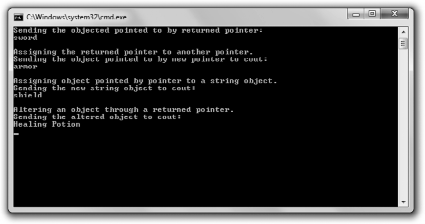
< Previous | Contents | Next >
Introducing the Inventory Pointer
The Inventory Pointer program demonstrates returning pointers. Through returned pointers, the program displays and even alters the values of a vector that holds a hero’s inventory. Figure 7.4 shows the results of the program.

Figure 7.4
A function returns a pointer (not a string object) to each item in the hero’s inventory.
You can download the code for this program from the Course Technology website (www.courseptr.com/downloads). The program is in the Chapter 7 folder; the filename is inventory_pointer.cpp.
// Inventory Pointer
// Demonstrates returning a pointer
#include <iostream> #include <string> #include <vector>
using namespace std;
//returns a pointer to a string element
string* ptrToElement(vector<string>* const pVec, int i);
int main()
{
240 Chapter 7 n Pointers: Tic-Tac-Toe 2.0
vector<string> inventory; inventory.push_back("sword"); inventory.push_back("armor"); inventory.push_back("shield");
//displays string object that the returned pointer points to
cout << "Sending the objected pointed to by returned pointer:\n"; cout << *(ptrToElement(&inventory, 0)) << "\n\n";
//assigns one pointer to another - - inexpensive assignment cout << "Assigning the returned pointer to another pointer.\n"; string* pStr = ptrToElement(&inventory, 1);
cout << "Sending the object pointed to by new pointer to cout:\n"; cout << *pStr << "\n\n";
//copies a string object - - expensive assignment
cout << "Assigning object pointed by pointer to a string object.\n"; string str = *(ptrToElement(&inventory, 2));
cout << "Sending the new string object to cout:\n"; cout << str << "\n\n";
//altering the string object through a returned pointer cout << "Altering an object through a returned pointer.\n";
*pStr = "Healing Potion";
cout << "Sending the altered object to cout:\n"; cout << inventory[1] << endl;
return 0;
}
string* ptrToElement(vector<string>* const pVec, int i)
{
//returns address of the string in position i of vector that pVec points to return &((*pVec)[i]);
}